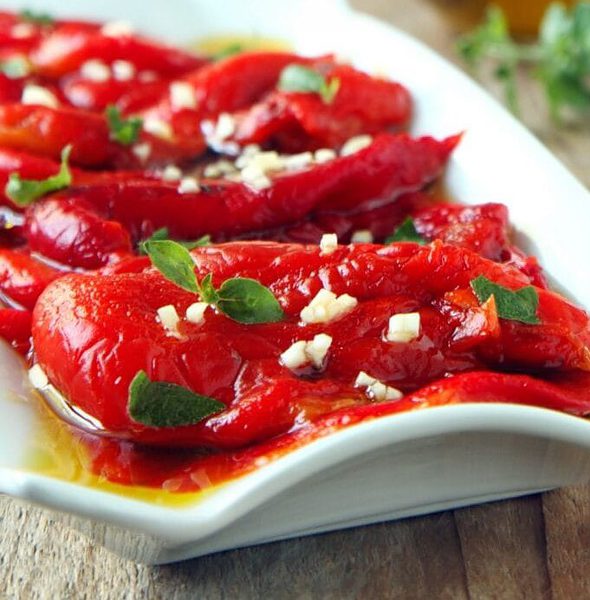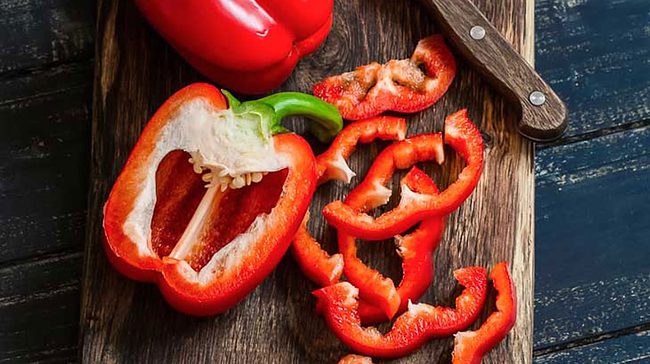
Why Mediterranean diet roasted red peppers with their high polyphenol content is a perfect companion for best olive oil to add colour and health benefits this Thanksgiving.
Bell peppers (Capsicum annuum) are fruits that belong to the nightshade family. They are related to chili peppers, tomatoes, and breadfruit, all of which are native to Central and South America.
Also called sweet peppers or capsicums, bell peppers can be eaten either raw or cooked.
Like their close relatives, chili peppers, bell peppers are sometimes dried and powdered. In that case, they are referred to as paprika.
They are low in calories and exceptionally rich in vitamin C and other antioxidants, making them an excellent addition to a healthy diet.
Bell peppers come in various colours, such as red, yellow, orange, and green which are unripe. Green, unripe peppers have a slightly bitter flavour and are not as sweet as fully ripe ones.
Roasted red peppers makes for the best hummus, pasta sauces, pizza or sandwich toppings. Red peppers are sweeter which is why they’re a more popular option for roasting. The high heat can give off a slightly bitter flavour, so the sweetness of red peppers is great for counteracting this. That being said, yellow or green peppers will still be great roasted up and soaked in garlic sauce.
Ingredients
- Regular red bell peppers if you can’t find pointed peppers.
- Garlic. You can use as much or as little as you like. Fresh is always best
- Morocco Gold extra virgin olive oil
- Water
- Salt: season to taste
- Parsley: chop up some fresh parsley to sprinkle and garnish over your peppers.
Instructions
- To use the oven, place the peppers on a parchment paper lined baking sheet under the broiler set on high. Keep an eye on them and turn the peppers once they char to get all sides.
- To use the stovetop, if you have a gas range, you can hold the peppers with tongs and carefully char them over a flame. For other stovetops heat a skillet over high heat and allow the peppers to char on each side.
- Peel the peppers, cut the top off, then peel the blistered skin away. Slice the peppers lengthwise and remove the seeds. I usually find this easier to do under running water, it cleans them nicely and you’re done in no time.
- Make the sauce and serve. Whisk together the garlic, extra virgin olive oil, water and salt. Mix the peppers with the sauce, garnish with parsley, and serve.

What Are Bell Peppers?
Fresh, raw bell peppers are mainly composed of water (92%). The rest is carbs and small amounts of protein and fat. Bell peppers are primarily composed of carbs, which account for most of their calorie content with 3.5 ounces (100 grams) holding 6 grams of carbs.
The carbs are mostly sugars such as glucose and fructose which are responsible for the sweet taste of ripe bell peppers.
Bell peppers also contain small amounts of fibre, 2% by fresh weight. Calorie for calorie, they are a very good fiber source.
Bell peppers are loaded with various vitamins and minerals:
- Vitamin C. One medium-sized red bell pepper provides 169% of the Reference Daily Intake (RDI) for vitamin C, making it one of the richest dietary sources of this essential nutrient.
- Vitamin B6. Pyridoxine is the most common type of vitamin B6, which is a family of nutrients important for the formation of red blood cells.
- Vitamin K1. A form of vitamin K, also known as phylloquinone, K1 is important for blood clotting and bone health.
- Potassium. This essential mineral may improve heart health.
- Folate. Also known as vitamin B9, folate has a variety of functions in your body. Adequate folate intake is very important during pregnancy.
- Vitamin E. A powerful antioxidant, vitamin E is essential for healthy nerves and muscles. The best dietary sources of this fat-soluble vitamin are oils, nuts, seeds, and vegetables.
- Vitamin A. Red bell peppers are high in pro-vitamin A (beta carotene), which your body converts into vitamin A.
Polyphenols In Bell Peppers
- Capsanthin. Especially high in red bell peppers, capsanthin is a powerful antioxidant responsible for their brilliant red colour.
- Violaxanthin. This compound is the most common carotenoid antioxidant in yellow bell peppers.
- Lutein. While abundant in green (unripe) bell peppers and black paprika, lutein is absent from ripe bell peppers. Adequate intake of lutein may improve eye health.
- Quercetin. Studies indicate that this polyphenol antioxidant may be beneficial for preventing certain chronic conditions, such as heart disease and cancer.
- Luteolin. Similarly to quercetin, luteolin is an polyphenol antioxidant that may have a variety of beneficial health effects.
Health benefits of bell peppers
Like most whole plant foods, bell peppers are considered a healthy food. High consumption of fruits and vegetables has been linked to a reduced risk of many chronic illnesses, such as cancer and heart disease. In addition, bell peppers may have a number of other health benefits.
Eye health
The most common types of visual impairments include macular degeneration and cataracts, the main causes of which are aging and infections. However, nutrition may also play a significant role in developing these diseases. Lutein and zeaxanthin — carotenoids found in relatively high amounts in bell peppers may improve eye health when consumed in adequate amounts. In fact, they protect your retina, the light-sensitive inner wall of your eye from oxidative damage.
A number of studies indicate that regular consumption of foods rich in these carotenoids may cut the risk of both cataracts and macular degeneration. Thus, adding bell peppers to your diet may help lower your risk of visual impairments.
Anemia prevention
Anemia is a common condition characterized by a reduced ability of your blood to carry oxygen. One of the most common causes of anemia is iron deficiency, the main symptoms of which are weakness and tiredness.
Not only are red bell peppers a decent source of iron, they are also exceptionally rich in vitamin C, which increases the absorption of iron from your gut. In fact, one medium-sized red bell pepper may contain 169% of the RDI for vitamin C.
Dietary iron absorption increases significantly when you consume fruits or vegetables high in vitamin C. For this reason, eating raw bell peppers alongside iron-rich foods — such as meat or spinach may help increase your body’s iron stores, cutting your risk of anemia.



